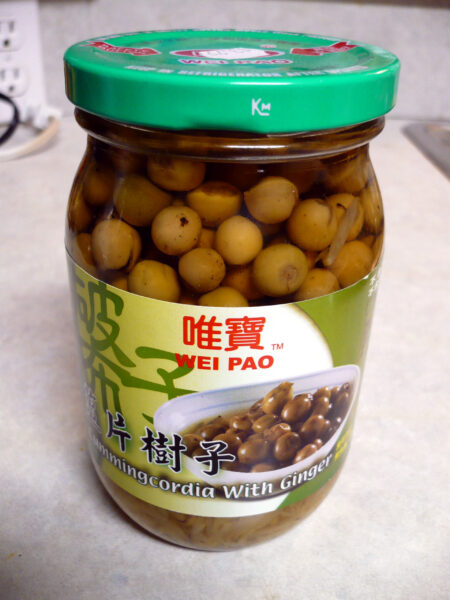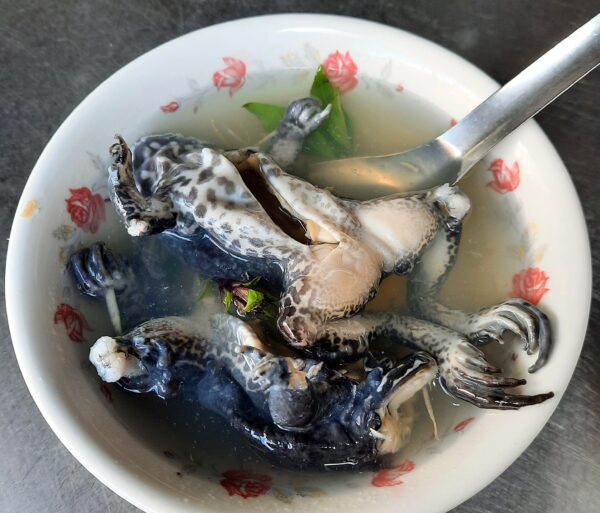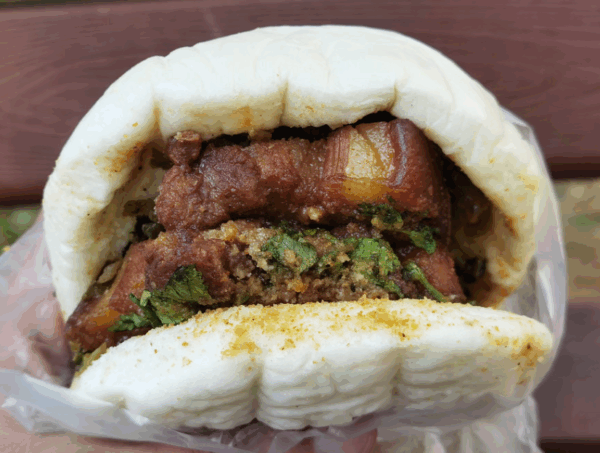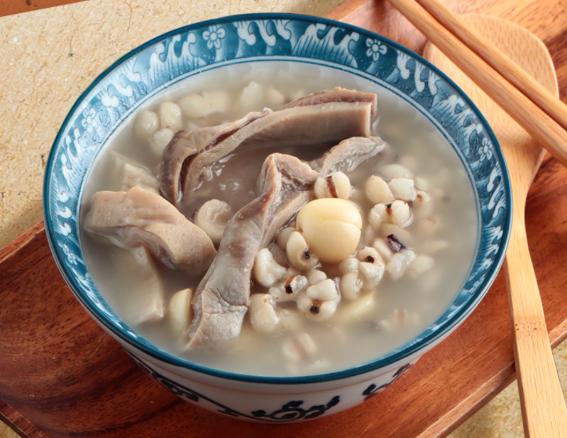British cuisine includes spotted dick and toad-in-the-hole, while Americans sometimes eat hush puppies or Dutch babies. But they’re not the only countries where people enjoy delicacies made from everyday ingredients yet carrying bizarre names. Read on to discover some of Taiwan’s strangely named foods!

Pickled cordia drupes sold by a Taiwanese supermarket
‘Shabby rags’ (破布子)
When Taiwanese people are speaking the language usually called Taiwanese, rather than Mandarin Chinese, they refer to the Cordia dichotoma tree and its edible drupes as pho-po-chi (‘shabby rags’), on account of its leaves often being chewed by insects. For many hundreds of years, people in Taiwan (both Han and indigenous) have been collecting these drupes, to add flavour to fish dishes or to store after dry roasting. There’s not much flesh on each drupe, as the pips are relatively large, but after pickling they’re downright tasty. Just be careful not to crack a tooth on a pip — they’re very hard!
‘Chicken roll’ (雞捲)
Its Mandarin Chinese name (ji-juan) notwithstanding, there’s not a speck of chicken in this snack. The old Taiwanese name is seldom used these days, but it gives some insight into the item’s origins: to-i-kng (多餘捲) meaning ‘leftovers-filled rolls’. They’re a bit like crépinette in France and sheftalia in Cyprus in that they contain meat and used to be wrapped in caul fat. This being Taiwan, the meat is invariably pork, and nowadays the exterior is usually tofu sheet. After frying in oil, these tubes are sliced into chunks, then eaten with a mild sweet/spicy dip.
Before Taiwan became a prosperous industrialised society, this food item was often served at the end of multicourse wedding banquets, to use up scraps generated in the prepping of other courses and to give people something they could take home. In the days of yore, it wasn’t unusual to walk half a day to get to a feast and another half day to get home afterwards, so any proper host would make sure guests had something to munch on during the long trek home…
‘Field chicken’ (田雞)

Frog soup at a restaurant in Beigang, Chiayi County
One particular amphibian species is known to Holo speakers as chui-ke (‘water chicken’), to Mandarin speakers as tian-ji (‘field chicken’), and to researchers as Hoplobatrachus rugulosus (East Asian bullfrog or Chinese/Taiwanese edible frog). These common names were not coined to save face; in Taiwan, there is nothing shameful about eating frog. Some say this species is so called because, when young, it sounds like a chicken, and the meat looks and tastes a bit like chicken. An alternative explanation has it that, during the Song Dynasty (960—1279) in China, there was a ban on the consumption of frogs because they ate insects which would otherwise destroy crops or spread disease. To keep the authorities off their backs, frog-meat aficionados were forced to devise a euphemism.
‘Tiger bites pig’ (虎咬豬)
The delicacy some refer to a ‘Taiwanese hamburger’ but which most Taiwanese call gua-bao (written 割包 or 刈包) has caught on in the English-speaking world, thanks to eateries like New York’s Baohaus and Bao in London. And no wonder: Each one features a slab of deliciously-soft braised pork (about the size of a deck of cards), tucked into a pouch of fluffy steamed bread and garnished with fresh cilantro, pickled mustard greens and crushed peanut. A light dusting of powdered sugar is optional.

A mouthwatering gua-bao about to be eaten in New Taipei City
Some vendors advertise their gua-bao under a different name, hu-yao-zhu, literally ‘tiger bites pig’. This label comes about from the appearance of a well-stuffed bun, like a pig struggling to escape from the jaws of a tiger. Other people have a different interpretation of the shape. Saying that they bear an auspicious resemblance to a purse overflowing with money, they serve them in the multicourse year-end weiya banquets through which companies thank and reward their employees for their hard work.
To the surprise of some visitors who’ve noticed the growing popularity of gua-bao overseas, these yummy snacks aren’t as ubiquitous in Taiwan as many other foods. What’s more, the type of pork and the precise garnishings varies hugely from vendor to vendor. So if you’re interested in trying ‘tiger bites pig’ — perhaps as part of a food-focused private guided tour of Taiwan — do let us know, and we’ll make sure it’s in the schedule.
‘Sewer soup’ (下水湯)
This is a dish name that confuses those who can read a certain amount of Chinese (such as travellers from Japan) but lack the cultural background that comes with growing up in Taiwan. Crude translations of this Chinese script include ‘underground water soup’ or even ‘sewer soup’ — neither of which are particularly appetising. Xia-shui-tang is in fact a soup packed with poultry offal (usually the liver, heart, gizzards, and blood of a chicken, duck, or goose). According to one theory, Taiwanese ended up calling it this because the Japanese (who ruled Taiwan as a colony from 1895 to 1945) adopted the name of a similar dish in England, haslet soup, rendering it in their own language before introducing it to speakers of Taiwanese. The latter naturally modified the pronunciation, and perhaps didn’t think about how it could be misconstrued.
‘Buddha Jumps Over the Wall’ (佛跳牆)
Whereas gua-bao and ji-juan are classic street foods, Buddha Jumps Over the Wall is a high-class banquet dish. Its name jokingly exaggerates its appeal, fans claiming that the mouthwatering fragrance of this complex soup-stew is so tantalizing that it’d tempt even a Buddhist monk committed to vegetarianism to forget his vows and clamber over a wall in order to taste it.
Buddha Jumps Over the Wall isn’t really a Taiwanese dish. Most probably it was invented in Fujian, the Chinese province nearest Taiwan and the ancestral homeland of many Taiwanese people. The recipe likely crossed the Taiwan Strait during the 19th century, and its reputation across the island was undoubtedly boosted by the post-1949 influx of educated and refined palates. Preparing the dish can take two full days and involve more than 30 top-tier ingredients. Among them are seafood (such as abalone, sea cucumber, scallops, and fish maw), land proteins (pork, ham, sometimes pigeon or duck), dried mushrooms, bamboo shoots, and quail eggs. These are combined and slow-cooked for hours in a special clay jar.

Green&Safe brand Four Deities Soup
In the past, Buddha Jumps Over the Wall usually included shark fin. Many restaurants in Taiwan have now dropped this ingredient altogether, and those that still serve shark fin are required to buy from fishermen who obey regulations designed to end the ecologically destructive practice of ‘finning’. You can form your own opinion about this controversial food item…
‘Four Deities Soup’ (四神湯)
No gods were harmed in the making of this soup! This popular dish actually gets it name from the number of medicinal ingredients it contains, the four typically being Chinese yam, Gorgon fruit, Job’s tears, and lotus seeds. The first is thought to enhance digestion and kidney function, while the second relieves a person of ‘excess mositure’ in their body. The third is said to be good for your skin, and the fourth is believed to calm both the mind and the digestive system. Often this soup contains strips of pork belly or chopped-up pig intestine but fully vegetarian versions aren’t difficult to find.
If these dishes whet your appetite so much you’re thinking of visiting Taiwan so you can enjoy them, contact us today so our expert itinerary designers can create a customised schedule matching your needs and desires. As of September 2025, Life of Taiwan’s private guided tours of Taiwan enjoy a rating of 4.9 out of 5.0 on TripAdvisor; of the 121 reviews, 114 rate us ‘excellent’.
